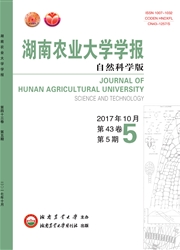

 中文摘要:
中文摘要:
为了给油菜科学施用氮肥提供依据,对油菜生长期间干物质累积、氮素吸收量及氮素生理效率的动态变化进行了研究.结果表明,油菜生物量随生育期延长而持续增加,其变化动态可用S曲线方程拟合;对干物质累积方程求导得到其累积速率,不同生育期干物质累积速率不同,最大累积速率出现在播种后126~156 d;氮素累积量从苗期到抽薹期增长较快,抽薹末期到开花末期有所下降,开花末期以后缓慢上升;随着生育期的进程植株含氮量持续下降,进入生殖生长期后生殖器官含氮量明显高于营养器官;氮素生理效率在开花期以前变化较小,开花期以后明显增加,在角果形成期达最高值.
 英文摘要:
英文摘要:
The dynamic variation for biomass, nitrogen absorbing amount and nitrogen physiological efficiency of oilseed rape during their growth developmental stages were studied. The result indicated that the biomass continuously increased with growing period, and their accumulations with time could be described by a S-curve shaped exponential regression equations. By differentiating the regression equations of dry matter accumulation, the rate of dry matter accumulation was obtained, which varied with different growing period. The maximum dry rate appeared during the 126~156th day after sowing. Nitrogen absorbing amount increased fast from seedling stage to bud stage; decreased from bud final stage to flowering final stage; slowly increased at the end of flowering stage. Nitrogen's contents continuously decreased with growing period and that in generative organs obviously higher than that in nutritive organs after reproductive stage. Nitrogen physiological efficiency varied slightly before flowering stage and then obviously increased, finally reached their peak in siliquing period.
 同期刊论文项目
同期刊论文项目
 同项目期刊论文
同项目期刊论文
 期刊信息
期刊信息
